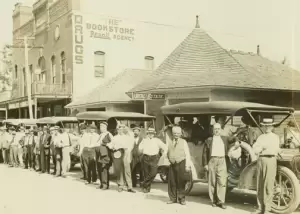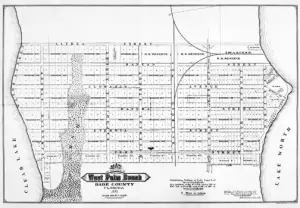The Other Side of Lake Worth
Starting From Scratch

Franklin Sheen came to West Palm Beach in 1893, started as an engineer for the Model Land Company, and left his mark in many places in Palm Beach County. Sheen became city engineer for West Palm Beach, county surveyor for ten years, and then opened a real estate office on Flagler Drive. The early roads of West Palm Beach were built under his direction, including Okeechobee Boulevard in 1909. Though Sheen became ill in 1909, he remained in charge of building roads until his death from tuberculosis in 1917. Sheen also gave the town of Pompano Beach its name, because he caught so many pompano there.

Albert W. Robert was Flagler’s first representative on Lake Worth in 1892, buying parcels of real estate in 1892 that Flagler had chosen on both sides of the lake. Later Robert worked from an office on Clematis Street, where he was succeeded by Wallace R. Moses. In a 1962 interview (on file at the HSPBC), Moses’s daughter, Sara (Moses) Dean, states that her mother named the original streets: Althea, Banyan, Clematis, Datura, Evernia, and Fern. The avenues ran alphabetically too, from Lantana on the east to Water on the west, although most of them were called “Street” for some time. Clematis was called “Avenue” until the 1920s. It started out with two ribbons of oyster shell as pavement, harvested from the Loxahatchee River and Indian shell mounds in Jupiter. Soon the streets within three blocks of the lakefront were paved. Daisy Butler Lyman recalled in a 1962 interview how the workers would grade the road by pounding the shells down with posts: “That’s about all they had to level ‘em off with.” On February 4, 1894, the town lots were offered for sale at an auction held in the ballroom of the Royal Poinciana Hotel.
 This 1893 map of West Palm Beach, Florida, by George W. Potter, County Surveyor, illustrates Henry Flagler’s desire to create a beautiful entrance to his island paradise of Palm Beach. The town was designed to be a residential and commercial center for his employees who were building and running the railroad, luxury hotels, and other independent businesses. This platted area is still the center of West Palm Beach.
This 1893 map of West Palm Beach, Florida, by George W. Potter, County Surveyor, illustrates Henry Flagler’s desire to create a beautiful entrance to his island paradise of Palm Beach. The town was designed to be a residential and commercial center for his employees who were building and running the railroad, luxury hotels, and other independent businesses. This platted area is still the center of West Palm Beach.

